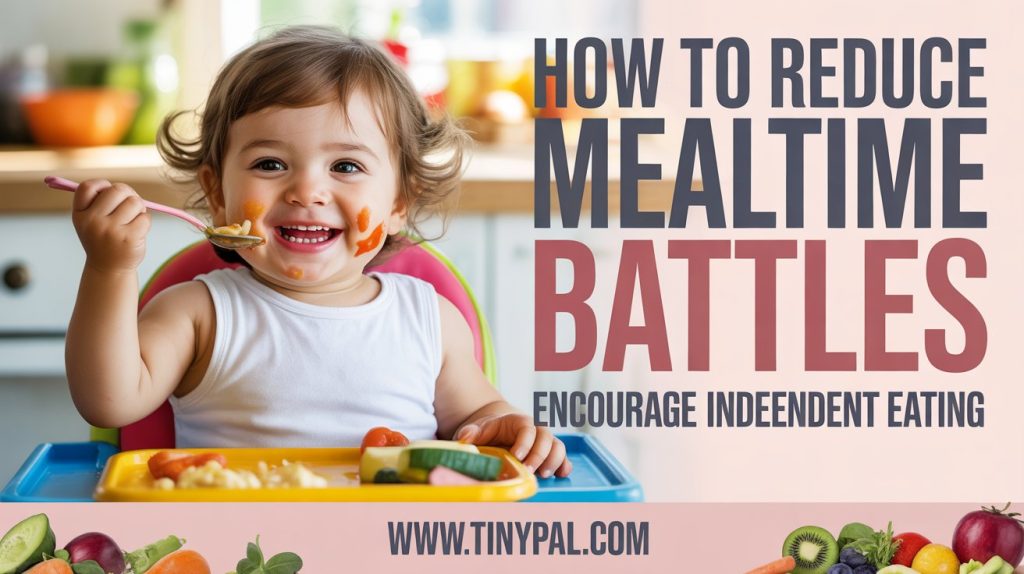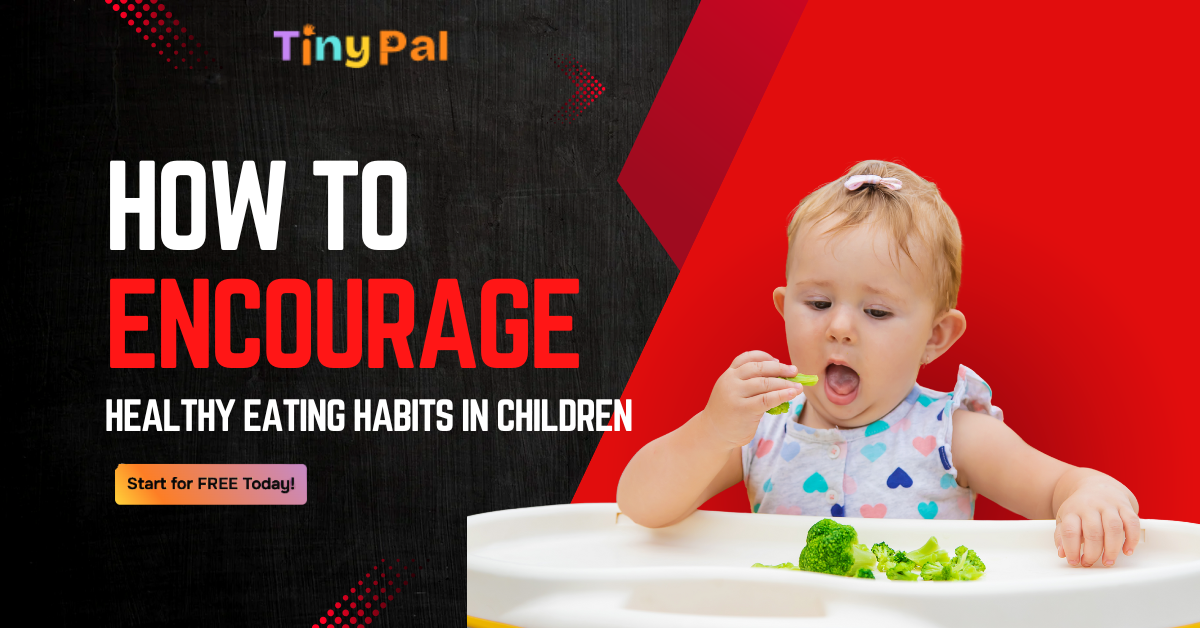How to Encourage Healthy Eating Habits in Children: A Parent’s Guide to Lifelong Wellness
It starts with something simple — a plate of vegetables.
You smile encouragingly, your child frowns, pokes at the broccoli, and says the familiar line:
“I don’t like it.”
A sigh escapes you, not out of anger but fatigue.
You just want your child to eat better — not perfectly, not everything — just something healthy.
If that sounds familiar, you’re not alone. Across the world, parents face the same challenge: how to encourage children to eat healthily without turning the table into a battlefield.
And that’s where TinyPal, your AI-powered parenting companion, steps in — not to lecture, but to guide. TinyPal helps you turn meals into mindful, joyful rituals that teach your child the value of good food and emotional connection.

Table of Contents
1. Redefine What “Healthy Eating” Really Means
Healthy eating isn’t about calories or control — it’s about relationship.
Children develop food habits not from what we tell them, but from what we model.
A “healthy eater” isn’t a child who avoids sweets — it’s one who:
- Enjoys a wide variety of foods.
- Listens to their hunger and fullness cues.
- Associates meals with comfort, not conflict.
TinyPal’s parenting insights start by redefining health beyond nutrition — focusing on emotional balance, mindfulness, and positive mealtime experiences.
“When children feel connected, they eat with curiosity — not fear.”
— TinyPal Parenting Philosophy
2. Model the Behavior You Want to See
Children mirror parents more than they obey them.
If you snack on fruits, explore flavors, and talk positively about food, they’ll imitate it naturally.
Eat together as often as possible. Describe your food with curiosity:
“These carrots are sweet today!”
“This soup feels warm and cozy.”
TinyPal’s Family Mealtime Framework encourages at least one shared meal a day, helping children build trust through observation — the foundation of lifelong healthy habits.
3. Make Food Fun, Not Forced
The fastest way to make kids reject food is pressure.
Replace “You must eat your greens” with playful curiosity:
- Turn vegetables into colorful patterns.
- Name smoothies after superheroes.
- Let them “design” their own sandwich.
TinyPal calls this the Play to Plate Principle — using creativity to transform healthy eating into self-motivated joy.
Because when kids associate food with fun, their willingness to try new things skyrockets.
4. Involve Kids in Food Choices
Children who participate in decisions are more likely to make better ones.
Invite them to:
- Pick one new fruit or vegetable each week.
- Help rinse or arrange ingredients.
- Plan family menus occasionally.
These micro-decisions teach responsibility, awareness, and pride — turning healthy eating from instruction into involvement.
TinyPal’s Child Participation Module encourages exactly this: small choices that build self-trust and cooperation.

5. Build a Routine — Structure Creates Security
Children thrive on predictability.
Set regular meal and snack times to stabilize energy and appetite.
Avoid grazing or constant snacking; instead, create structured eating rhythms.
TinyPal’s smart scheduling system helps parents balance nutrition, sleep, and playtime to promote consistent, calm meals.
When children know when to expect food, they’re less anxious — and more open to trying new things.
6. Expose, Don’t Enforce
It can take 8–12 exposures for a child to accept a new food.
That’s normal — not resistance.
Keep offering new foods without expectation.
Serve small portions alongside favorites.
Say:
“You don’t have to eat it, just explore it.”
TinyPal’s Nudging Technique leverages gentle repetition and positive exposure — training parents to stay patient while the child’s comfort zone expands gradually.
7. Create a Calm Mealtime Environment
Turn off the TV. Put phones aside.
Make meals about conversation and presence.
TinyPal’s Digital-Free Dining Mode guides parents to create mindful mealtime atmospheres, enhancing emotional focus and digestion.
When children feel your attention, they eat more calmly — and more willingly.
8. Teach the “Rainbow Rule”
Instead of saying “Eat vegetables,” say:
“Let’s see how many colors we can eat today!”
Color-based goals (green spinach, red tomato, orange carrot) make nutrition tangible and fun.
TinyPal’s visual learning tools gamify this approach — tracking color diversity weekly, rewarding curiosity over compliance.
This makes healthy eating measurable, exciting, and child-driven.
9. Avoid Using Food as a Reward or Punishment
Saying “If you finish your food, you get dessert” may seem harmless — but it creates unhealthy emotional links.
Instead, teach neutrality:
All foods have a place — balance matters more than bribes.
TinyPal’s Emotional Food Mapping explains how reward-based eating triggers guilt and anxiety later in life — helping parents shift toward positive emotional associations.
10. Respect Appetite and Autonomy
Forcing a child to eat disconnects them from their internal cues.
Trust them to stop when full and eat when hungry.
Encourage self-awareness by saying:
“Listen to your tummy — is it full or still hungry?”
TinyPal helps parents interpret these cues scientifically, using behavioral insights to promote emotional eating awareness — the foundation of lifelong mindful eating.
11. Celebrate Effort, Not Perfection
Don’t focus on what’s left on the plate. Celebrate exploration.
“You tried something new today — that’s wonderful!”
“You helped make dinner — thank you!”
TinyPal’s behavioral reinforcement system gives parents daily affirmations to acknowledge curiosity and courage — the true drivers of long-term healthy habits.
12. Lead with Love, Not Fear
Healthy eating isn’t about control; it’s about connection.
When your child feels safe, seen, and supported, they’ll trust you — and themselves — enough to make good food choices.
TinyPal embodies this very principle — blending emotional science with AI to help parents respond calmly, not react anxiously.
“You don’t teach nutrition — you model nourishment.”
— TinyPal Parenting Insight
The TinyPal Advantage: Nurturing Health with Emotional Intelligence
TinyPal isn’t a meal tracker or calorie counter.
It’s a personal parenting companion that grows with your family — helping you understand your child’s behaviors, emotions, and rhythms with empathy.
With TinyPal, you can:
- Build mealtime routines that reduce stress.
- Personalize strategies for your child’s personality.
- Encourage healthy habits that last a lifetime.
👉 Download the TinyPal Parenting App
and discover how AI + empathy can transform your child’s relationship with food.

How to Reduce Mealtime Battles
Parent Testimonials
“TinyPal helped me stop turning food into fights. My daughter now asks for fruits herself!”
— Emily, UK
“We learned to make meals calm and colorful. TinyPal taught us that connection matters more than control.”
— Harini, India
“I love how TinyPal explains my child’s behavior scientifically. It’s like a parenting therapist in my pocket.”
— Monica, UAE

